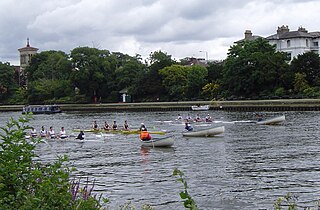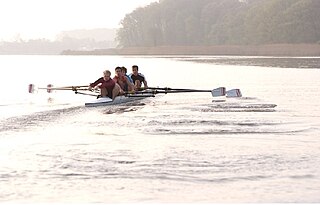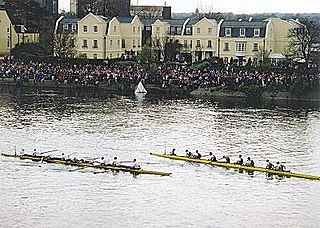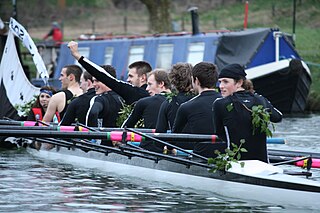
Rowing, often called crew in the United States, is the sport of racing boats using oars. It differs from paddling sports in that rowing oars are attached to the boat using rowlocks, while paddles are not connected to the boat. Rowing is divided into two disciplines: sculling and sweep rowing. In sculling, each rower holds two oars, one in each hand, while in sweep rowing each rower holds one oar with both hands. There are several boat classes in which athletes may compete, ranging from single sculls, occupied by one person, to shells with eight rowers and a coxswain, called eights. There are a wide variety of course types and formats of racing, but most elite and championship level racing is conducted on calm water courses 2 kilometres (1.2 mi) long with several lanes marked using buoys.

Lake Union is a freshwater lake located entirely within the city limits of Seattle, Washington, United States. It is a major part of the Lake Washington Ship Canal, which carries fresh water from the much larger Lake Washington on the east to Puget Sound on the west. The easternmost point of the lake is the Ship Canal Bridge, which carries Interstate 5 over the eastern arm of the lake and separates Lake Union from Portage Bay. Lake Union is the namesake of the neighborhoods located on three of its shores: Eastlake, Westlake and South Lake Union. Notable destinations on the lake include Lake Union Park, the Museum of History & Industry (MOHAI), and the Center for Wooden Boats on the southern shore and Gas Works Park on the northern shore.

Empacher is a manufacturer of boats. Today, they produce racing shells for the sport of rowing.

In watercraft, a racing shell is an extremely narrow, and often comparatively long, rowing boat specifically designed for racing or exercise. It is equipped with long oars, outriggers to hold the oarlocks away from the boat, and sliding seats. The boat's long length and semicircular cross-section reduce drag to a minimum. This makes the boat both fast and unstable. It must be balanced by the rowers to avoid tipping. Being able to balance – or "set" – the boat while putting maximum effort into the oars is therefore an essential skill of sport rowing.

Vespoli USA is a manufacturer of rowing shells. It was founded by former Georgetown University rower and Olympian Mike Vespoli in 1980.

Sykes Racing is an Australian manufacturer of rowing shells. The boats are widely popular by Australian rowers from schools through to Olympians.

PLU Crew is the varsity rowing program for Pacific Lutheran University in Tacoma, Washington. The team was founded in 1964 as a joint program with University of Puget Sound. Today the team consists of Men's and Women's programs for both Varsity and Novice rowers, and competes as a member of the Northwest Collegiate Rowing Conference (NCRC) and Western Intercollegiate Rowing Association (WIRA).

A single scull, abbreviated as a 1x, is a racing shell designed for a single person who propels the boat with two oars, one in each hand.
Conal P. Groom is an American competition competitive rower and coach. He co-founded Seattle Rowing Center with Carol Nagy, the former junior novice coach at Lake Union Crew and business manager at Pocock Rowing Center. In 2019, Groom moved to mountains outside Santa Barbara, California.

A double scull, also abbreviated as a 2x, is a rowing boat used in the sport of competitive rowing. It is designed for two persons who propel the boat by sculling with two oars each, one in each hand.

A quadruple sculling boat, often simply called a quad and abbreviated as a 4x, is a racing shell used in the sport of competitive rowing. It is designed for four people who propel the boat by sculling with two oars, or "sculls", one in each hand.

A coxed four, abbreviated as a 4+, is a racing shell used in the sport of competitive rowing. It is designed for four persons who propel the boat with sweep oars and is steered by a coxswain.

A coxless four, abbreviated as a 4- and also called a straight four, is a racing shell used in the sport of competitive rowing. It is designed for four persons who propel the boat with sweep oars, without a coxswain.

An eight, abbreviated as an 8+, is a racing shell used in competitive rowing (crew). It is designed for eight rowers, who propel the boat with sweep oars, and is steered by a coxswain, or "cox".

George Yeomans Pocock was a leading designer and builder of racing shells in the 20th century.

The George Pocock Memorial Rowing Center is an amateur rowing club famous for its namesake and its ability to produce world-class rowers.

Stämpfli Racing Boats is a British-based manufacturer of rowing boats. Stämpfli was founded in Switzerland by Johann Friedrich August Stämpfli in 1896. Manufacturing originally took place in Zurich, Switzerland, but moved to Surrey, England after the company was acquired by Janousek Racing Boats in 1991. Stämpfli is a subdivision of Janousek boats, Stämpfli produce generally slimmer boats which are more popular amongst competitive rowers at a club level.

Alden Rowing manufactures sliding-seat rowing boats. Their original product, the Alden Ocean Shell, was designed in 1970 or 1971. Traditional shell designs use high aspect ratio hulls, with long waterline with minimum beam, that emphasize racing performance at the cost of stability. These types of boats are only usable on flat water. Alden, however, specializes in shorter, beamier, highly stable designs which are suitable for rowing in open water, where swells are commonly encountered. As of 2004, Alden had sold 25,000 shells.

The Associated Students of the University of Washington (ASUW) Shell House, also known as the UW Canoe House, is a historic building on the University of Washington campus in Seattle, Washington. The building was constructed in 1918 as a Navy seaplane hangar during World War I. It was later used as a shell house for the University of Washington men's rowing team from 1920 to 1949 and a canoe rental space until 1975. The building is located northeast of the Montlake Cut on Union Bay.

















